Restoring Summer Base Flow under a Decentralized Water Management Regime: Constraints, Opportunities, and Outcomes in Mediterranean-Climate California
Abstract
:1. Introduction
2. Defining Constraints and Opportunities
2.1. Constraints
2.1.1. Climatic Effects: Low Summer Rainfall and Inter-Annual Variability
2.1.2. Decentralized Water Management
2.1.3. California’s Dual Water Rights System
2.1.4. Land Ownership Characteristics
2.1.5. Institutional Fragmentation
2.2. Opportunities
2.2.1. Abundance of Water in Winter
2.2.2. Planning Tools
2.2.3. Drought as an Opportunity
2.2.4. A Well-Cultivated “Egosystem”
2.2.5. Salmon as Charismatic Megafauna
2.2.6. An Increase in Funding Sources
3. Preliminary Conservation Outcomes
3.1. Grape Creek
3.2. Dutch Bill Creek
3.3. Mill Creek
4. Discussion
4.1. Role of Science in Restoration
4.2. The Importance of a Healthy Egosystem
4.3. Costs and Benefits
4.4. Application beyond the Russian River Watershed
5. Conclusions
Acknowledgments
Author Contributions
Conflicts of Interest
References
- State Water Resources Control Board. Policy for Maintaining Instream Flows in Northern California Coastal Streams; SWRCB Division of Water Rights, California Environmental Protection Agency: Sacramento, CA, USA, 2010.
- National Marine Fisheries Service. Final Recovery Plan for Central California Coast Coho Salmon Evolutionarily Significant Unit; National Marine Fisheries Service, Southwest Region: Santa Rosa, CA, USA, 2012.
- Langridge, R. Changing Legal Regimes and the Allocation of Water between Two California Rivers. Natl. Resour. J. 2002, 42, 283–330. [Google Scholar]
- Deitch, M.J.; Kondolf, G.M.; Merenlender, A.M. Surface water balance to evaluate the hydrological impacts of small instream diversions and application to the Russian River basin, California, USA. Aquat. Conserv. Mar. Freshw. Ecosyst. 2009, 19, 274–284. [Google Scholar] [CrossRef]
- Gasith, A.; Resh, V.H. Streams in Mediterranean climate regions: Abiotic influences and biotic responses to predictable seasonal events. Annu. Rev. Ecol. Syst. 1999, 17, 51–81. [Google Scholar] [CrossRef]
- Beche, L.A.; Mcelravy, E.P.; Resh, V.H. Long-term seasonal variation in the biological traits of benthic-macroinvertebrates in two Mediterranean-climate streams in California, USA. Freshw. Biol. 2006, 51, 56–75. [Google Scholar] [CrossRef]
- Resh, V.H.; Beche, L.A.; Lawrence, J.E.; Mazor, R.D.; McElravy, E.P.; O’Dowd, A.P.; Rudnick, D.; Carlson, S.M. Long-term population and community patterns of benthic macroinvertebrates and fishes in Northern California Mediterranean-climate streams. Hydrobiologia 2012. [Google Scholar] [CrossRef]
- Bogan, M.T.; Hwan, J.L.; Carlson, S.M. High aquatic biodiversity in an intermittent coastal headwater stream at Golden Gate National Recreation Area, California. Northwest Sci. 2015, 89, 188–197. [Google Scholar] [CrossRef]
- Moyle, P.B. Inland Fishes of California; University of California Press: Berkeley, CA, USA, 2002. [Google Scholar]
- Harvey, B.C.; Nakamoto, R.J.; White, J.L. Reduced streamflow lowers dry-season growth of rainbow trout in a small stream. Trans. Am. Fish. Soc. 2006, 135, 998–1005. [Google Scholar] [CrossRef]
- Grantham, T.E.; Newburn, D.A.; McCarthy, M.A.; Merenlender, A.M. The role of streamflow and land use in limiting oversummer survival of juvenile steelhead in California streams. Trans. Am. Fish. Soc. 2012, 141, 585–598. [Google Scholar] [CrossRef]
- Kleinfelder Inc. Pilot Study of Groundwater Conditions in the Joy Road, Mark West Springs, and Bennett Valley Areas of Sonoma County, California; Sonoma County Permit Resource Management Department: Santa Rosa, CA, USA, 2004.
- Johnson, B.J. Reasonable Use on the Russian River: A Brief History of the Frost Protection Rule. Gold. Gate Univ. Environ. Law J. 2016, 9, 41–65. [Google Scholar]
- Moyle, P.B. Novel aquatic ecosystems: The new reality for streams in California and other Mediterranean climate regions. River Res. Appl. 2014, 30, 1335–1344. [Google Scholar] [CrossRef]
- Deitch, M.J.; Kondolf, G.M.; Merenlender, A.M. Hydrologic impacts of small-scale instream diversions for frost protection and heat protection in the California wine country. River Res. Appl. 2009, 25, 118–134. [Google Scholar] [CrossRef]
- Gilvear, D.J.; Spray, C.J.; Casas-Mulet, R. River rehabilitation for the delivery of multiple ecosystem services at the river network scale. J. Environ. Manag. 2013, 126, 30–43. [Google Scholar] [CrossRef] [PubMed]
- Beechie, T.; Pess, G.; Roni, P.; Giannico, G. Setting river restoration priorities: A review of approaches and a general protocol for identifying and prioritizing actions. N. Am. J. Fish. Manag. 2008, 28, 891–905. [Google Scholar] [CrossRef]
- Barmuta, L.A.; Linke, S.; Turak, E. Bridging the gap between ‘planning’ and ‘doing’ for biodiversity conservation in freshwaters. Freshw. Biol. 2011, 56, 180–195. [Google Scholar] [CrossRef]
- Deitch, M.J.; Goodfellow, M.; Feirer, S.T. Spatial and temporal variability of rainfall among Mediterranean climate regions across the globe. Water 2016. under review. [Google Scholar]
- Deitch, M.J.; Kondolf, G.M. Salmon in a Mediterranean Climate: California’s Incendiary Mix. In Sustainable Water: Challenges and Solutions from California; Lassiter, A., Ed.; University of California Press: Berkeley, CA, USA, 2015; pp. 269–291. [Google Scholar]
- Van Dijk, A.I.; Beck, H.E.; Crosbie, R.S.; Jeu, R.A.; Liu, Y.Y.; Podger, G.M.; Timbal, B.; Viney, N.R. The Millennium Drought in southeast Australia (2001–2009): Natural and human causes and implications for water resources, ecosystems, economy, and society. Water Resour. Res. 2013, 49, 1040–1057. [Google Scholar] [CrossRef]
- Hwan, J.L.; Carlson, S.M. Fragmentation of an Intermittent Stream during Seasonal Drought: Intra-annual and Interannual Patterns and Biological Consequences. River Res. Appl. 2015, 32, 856–870. [Google Scholar] [CrossRef]
- Wilhite, D.A.; Hayes, M.J.; Knutson, C.L. Drought preparedness planning: Building institutional capacity. In Drought and Water Crises: Science, Technology, and Management Issues; Wilhite, D.A., Ed.; CRC Press: Boca Raton, FL, USA, 2005; pp. 93–135. [Google Scholar]
- Keeley, J.E. Native American impacts on fire regimes of the California coastal ranges. J. Biogeogr. 2002, 29, 303–320. [Google Scholar] [CrossRef]
- Deitch, M.J.; van Docto, M.; Feirer, S.T. A spatially explicit framework for assessing the effects of weather and water rights on streamflow. Appl. Geogr. 2016, 67, 14–26. [Google Scholar] [CrossRef]
- Serra-Llobet, A.; Conrad, E.; Schaefer, K. Governing for Integrated Water and Flood Risk Management: Comparing Top-Down and Bottom-Up Approaches in Spain and California. Water 2016, 8, 445. [Google Scholar] [CrossRef]
- California State Water Resources Control Board. California Code of Regulations, Title 23: Excerpts of Divisions 3–5 Applicable to the Administration of Water Rights; SWRCB Division of Water Rights, California Environmental Protection Agency: Sacramento, CA, USA, 2016. Available online: http://www.waterboards.ca.gov/laws_regulations/docs/wrregs.pdf (accessed on 1 November 2016).
- Sax, J.L.; Thompson, B.H.; Leshy, J.D.; Abrams, R.H. Legal Control of Water Resources: Cases and Materials, 3rd ed.; West Group Publishing: St. Paul, MN, USA, 2000. [Google Scholar]
- Littleworth, A.L.; Garner, E.L. California Water II; Solano Press: Point Arena, CA, USA, 2007. [Google Scholar]
- State Water Resources Control Board, Division of Water Rights. eWRIMS GIS Application. Available online: https://waterrightsmaps.waterboards.ca.gov/ewrims/gisapp.aspx (accessed on 1 November 2016).
- Hanemann, M.; Dyckman, C.; Park, D. California’s flawed surface water rights. In Sustainable Water: Challenges and Solutions from California; Lassiter, A., Ed.; University of California Press: Berkeley, CA, USA, 2015; pp. 52–82. [Google Scholar]
- Fitchette, T. California Grape Vineyard Values Remain Strong; Western Farm Press: Fresno, CA, USA, 15 December 2015; Available online: http://www.westernfarmpress.com/grapes/california-grape-vineyard-values-remain-strong (accessed on 1 November 2016).
- Grantham, T.E.; Merenlender, A.M.; Resh, V.H. Climatic influences and anthropogenic stressors: An integrated framework for streamflow management in Mediterranean-climate California, USA. Freshw. Biol. 2010, 55, 188–204. [Google Scholar] [CrossRef]
- Trout Unlimited and Center for Ecosystem Management and Restoration. Grape Creek Streamflow Improvement Plan; Trout Unlimited California: Berkeley, CA, USA, 2013; Available online: https://caseagrant.ucsd.edu/sites/default/files/Grape%20Creek%20Streamflow%20Improvement%20Plan%20%28Pub%20Date%20April%202013%29_0.pdf (accessed on 1 November 2016).
- Mill Creek Streamflow Improvement Plan. Produced by The Russian River Coho Water Resources Partnership, Comprised of the Center for Ecosystem Management and Restoration, Gold Ridge Resource Conservation District, Occidental Arts and Ecology Center WATER Institute, Sonoma Resource Conservation District, Trout Unlimited California, and University of California Sea Grant. 2014. Available online: http://cohopartnership.org/Mill-Creek-Streamflow.pdf (accessed on 01 November 2016).
- Deitch, M.J.; Merenlender, A.M.; Feirer, S.T. Cumulative effects of small reservoirs on streamflow in northern Coastal California catchments. Water Resour. Manag. 2013. [Google Scholar] [CrossRef]
- California Department of Fish and Wildlife. State Streamlines Domestic Water Tank Storage Process in Response to Drought; California Department of Fish and Wildlife: Sacramento, CA, USA, 2014; Available online: https://cdfgnews.wordpress.com/2014/03/13/state-streamlines-domestic-water-tank-storage-process-in-response-to-drought/ (accessed on 1 November 2016).
- Kovner, G. Sonoma County Vineyard Owners Lauded for Water Conservation; Santa Rosa Press Democrat: Santa Rosa, CA, USA, 5 October 2015; Available online: http://www.pressdemocrat.com/news/4555747-181/sonoma-county-vineyard-owners-lauded (accessed on 1 November 2016).
- Bouleau, G.; Kondolf, M. Rivers of Diversity: Water Regulation in California and the EU. In Transatlantic Regulatory Cooperation: The Shifting Roles of the EU, the US and California; Vogel, D., Swinnen, J.F.M., Eds.; Edward Elgar: Cheltenham, UK, 2011; pp. 83–101. [Google Scholar]
- Montgomery, D. King of Fish: The Thousand-Year Run of Salmon; Westview Press: Boulder, CO, USA, 2003. [Google Scholar]
- Smith, R.J.; Klonsky, K.M.; Livingston, P.L.; DeMoura, R.L. Sample Costs to Establish a Vineyard and Produce Wine Grapes: North Coast Region Sonoma County; University of California Cooperative Extension: Davis, CA, USA, 2004. [Google Scholar]
- Obedzinski, M.; Pecharich, J.C.; Davis, J.A.; Nossaman, S.; Olin, P.G.; Lewis, D.G. Russian River Coho Salmon Captive Broodstock Program Monitoring Activities: Annual Report, July 2007 to June 2008; University of California Cooperative Extension and Sea Grant Program: Santa Rosa, CA, USA, 2009. [Google Scholar]
- Asarian, J.E.; Walker, J.D. Long-Term Trends in Streamflow and Precipitation in Northwest California and Southwest Oregon, 1953–2012. J. Am. Water Resour. Assoc. 2016, 52, 241–261. [Google Scholar] [CrossRef]
- May, C.L.; Lee, D.C. The relationships among in-channel sediment storage, pool depth, and summer survival of juvenile salmonids in Oregon Coast Range streams. N. Am. J. Fish. Manag. 2004, 24, 761–774. [Google Scholar] [CrossRef]
- Stubblefield, A.; Kaufman, M.; Blomstrom, G.; Rogers, J. Summer Water Use by Mixed-Age and Young Forest Stands, Mattole River, Northern California, USA; General Technical Reports PSW-GTR-238; Pacific Southwest Research Station, Forest Service, U.S. Department of Agriculture: Albany, CA, USA, 2012.
- Kovner, G. Flowing Again, Russian River’s Creeks Open for Spawning Coho Salmon; The Santa Rosa Press Democrat: Santa Rosa, CA, USA, 21 December 2015; Available online: http://www.pressdemocrat.com/news/4962232-181/flowing-again-russian-rivers-creeks?artslide=0 (accessed on 1 November 2016).
- Georgakakos, A.P.; Yao, H.; Kistenmacher, M.; Georgakakos, K.P.; Graham, N.E.; Cheng, F.Y.; Spencer, C.; Shamir, E. Value of adaptive water resources management in Northern California under climatic variability and change: Reservoir management. J. Hydrol. 2012, 412, 34–46. [Google Scholar] [CrossRef]
- Cook, B.I.; Ault, T.R.; Smerdon, J.E. Unprecedented 21st century drought risk in the American Southwest and Central Plains. Sci. Adv. 2015, 1, e1400082. [Google Scholar] [CrossRef] [PubMed]
- Downs, P.W.; Kondolf, G.M. Post-project appraisals in adaptive management of river channel restoration. Environ. Manag. 2002, 29, 477–496. [Google Scholar] [CrossRef]
- Berkes, F.; Turner, N.J. Knowledge, learning and the evolution of conservation practice for social-ecological system resilience. Hum. Ecol. 2006, 34, 479–494. [Google Scholar] [CrossRef]
- Berkes, F. Rethinking community-based conservation. Conserv. Biol. 2004, 18, 621–630. [Google Scholar] [CrossRef]
- Morrison, M.; Oczkowski, E.; Greig, J. The primacy of human capital and social capital in influencing landholders’ participation in programmes designed to improve environmental outcomes. Aust. J. Agric. Resour. Econ. 2011, 55, 560–578. [Google Scholar] [CrossRef]
- State Water Resources Control Board. Order WR 2015-0026-DWR Order for Additional Information in the Matter of Diversion of Water from Dutch Bill Creek, Green Valley Creek, Portions of Mark West Creek, and Mill Creek Watersheds; California Environmental Protection Agency: Sacramento, CA, USA, 2015. Available online: http://www.waterboards.ca.gov/waterrights/water_issues/programs/drought/rrtribs.shtml (accessed on 1 November 2016).
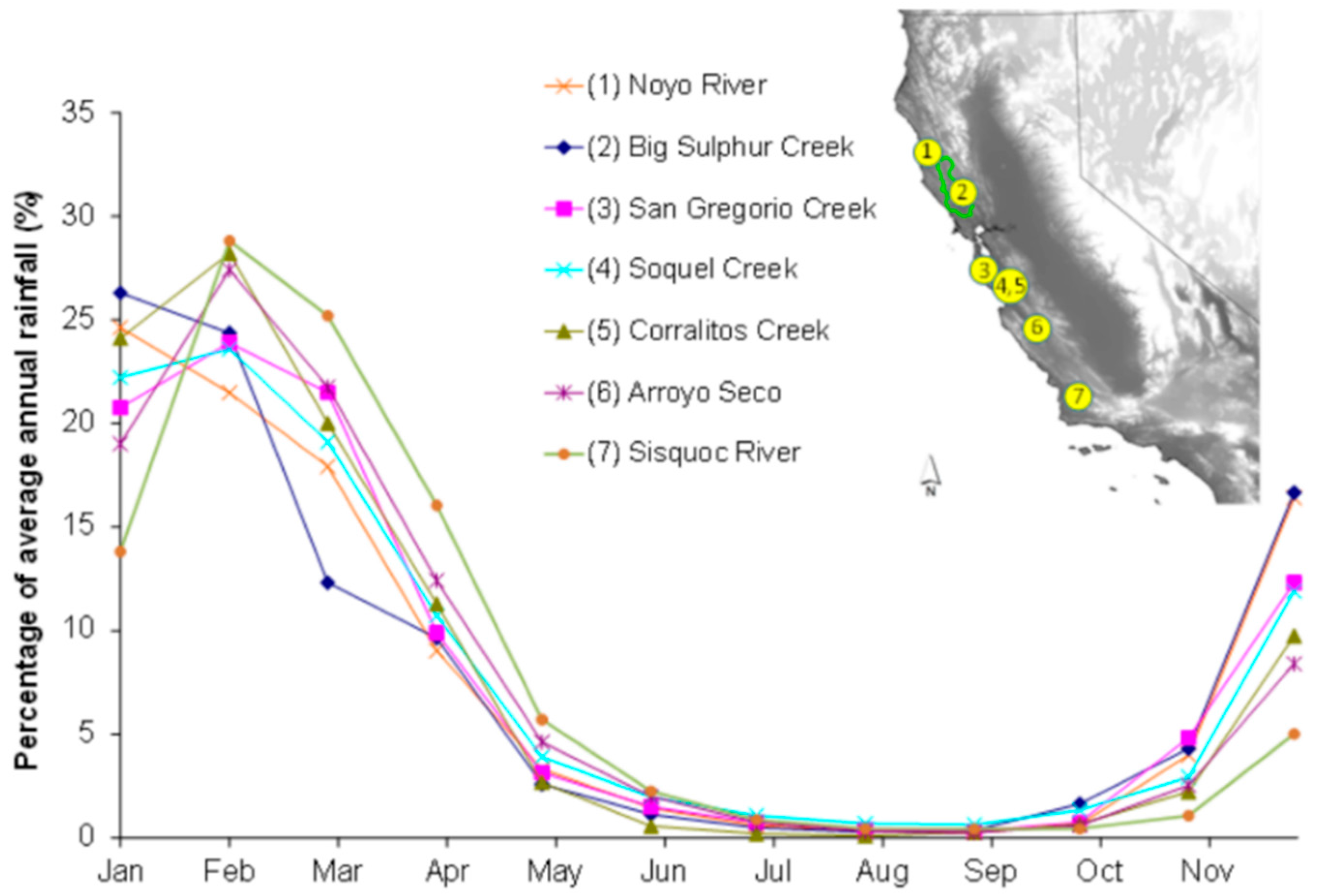
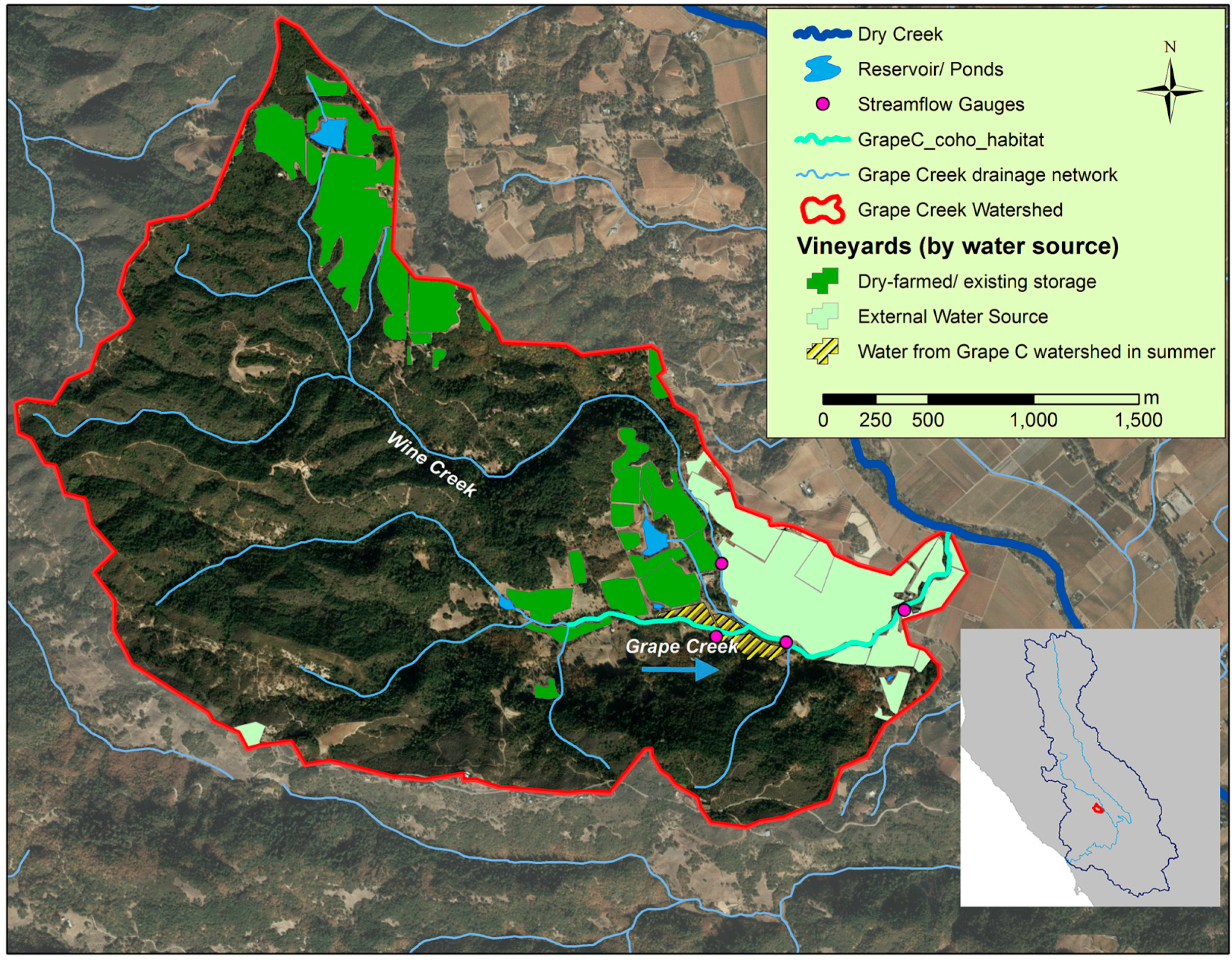
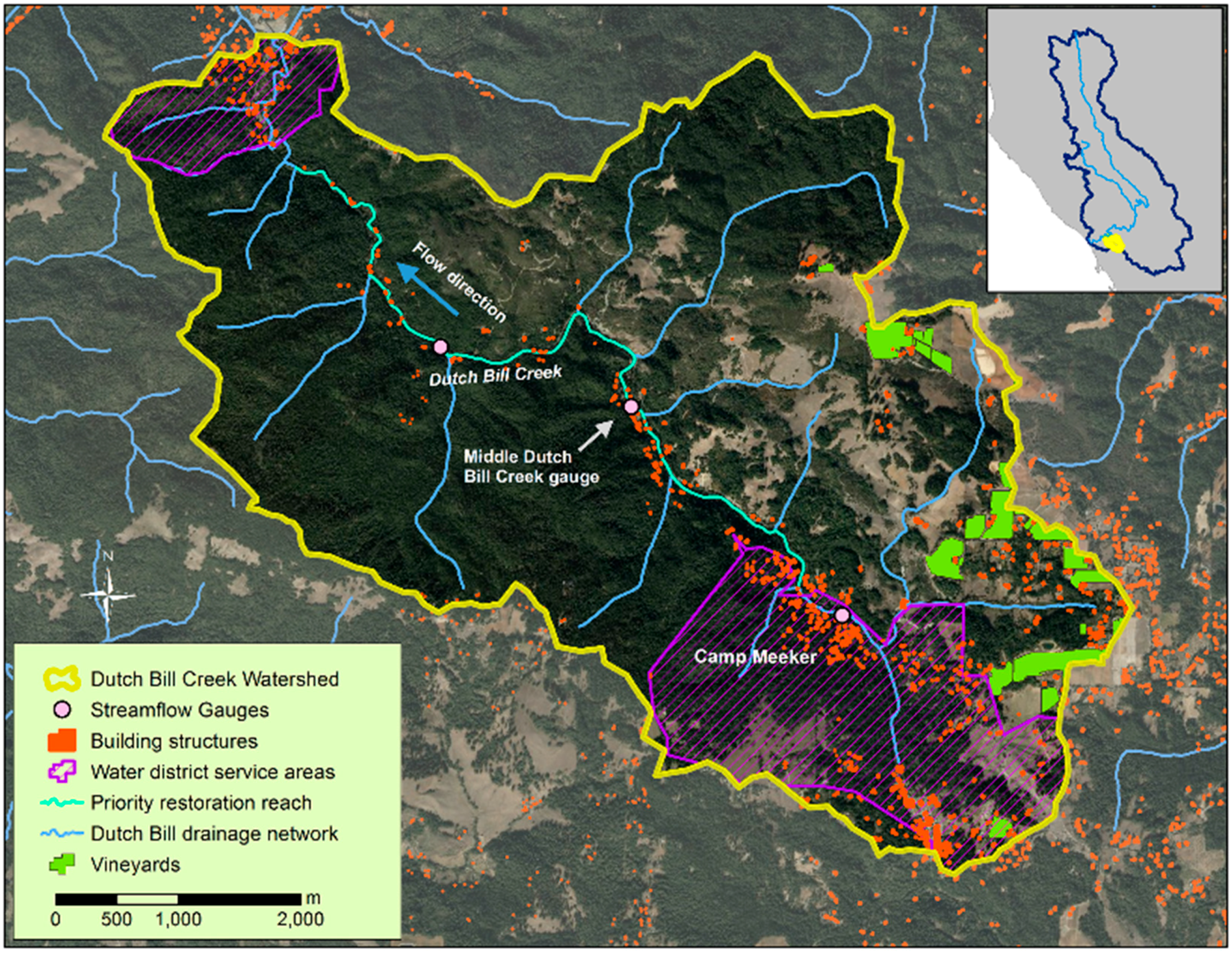
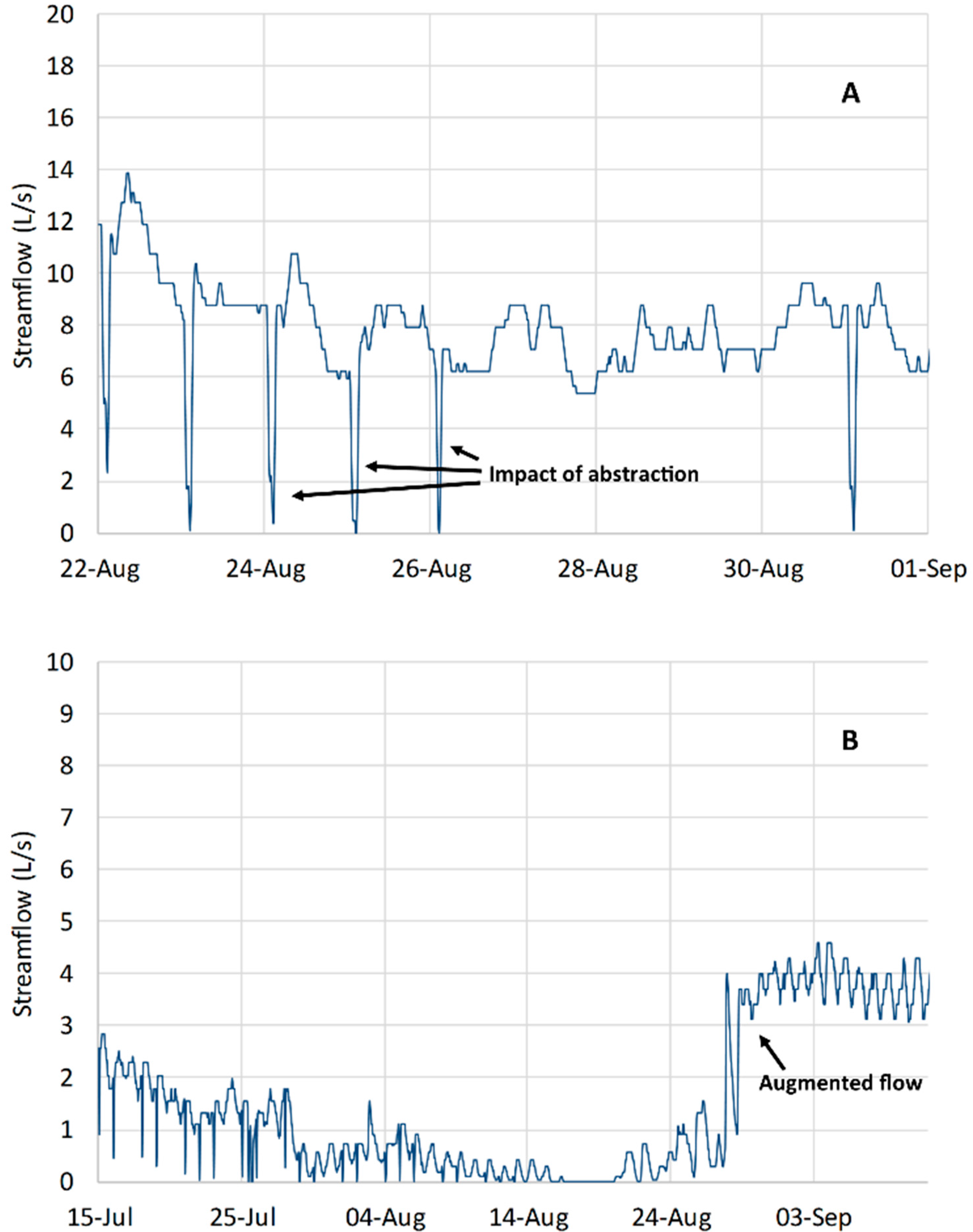
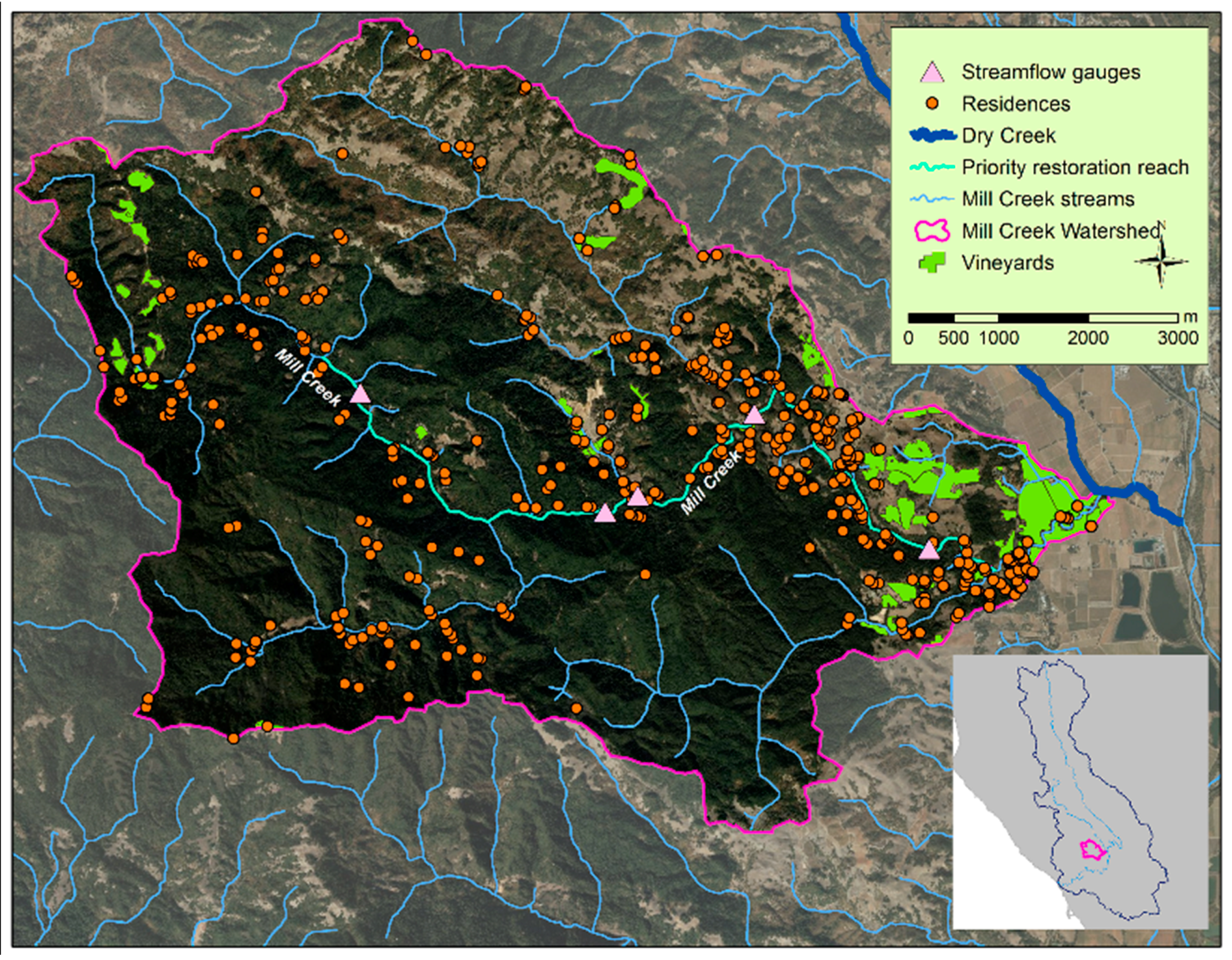

| Step 1: identifying problem/defining objectives | |||
| Constraints: | Opportunities: | ||
| Low summer rainfall/inter-annual variability | In Grape Creek, Mill Creek, and Dutch Bill Creek, the summer dry season results in streamflow on same order of magnitude as typical water abstractions. | Winter water abundance | In Grape Creek, Mill Creek, and Dutch Bill Creek, the water needed annually for human uses represents less than 5% of average winter rainfall and less than 10% of average winter stream discharge. |
| Dual water rights system | In Grape Creek, Mill Creek, and Dutch Bill Creek, more people obtain water through riparian right in summer than through appropriative right in winter. | ||
| STEP 2: CONDUCTING ASSESSMENTS | |||
| Constraints: | Opportunities: | ||
| Low summer rainfall/inter-annual variability | In Grape Creek and Mill Creek, naturally low flow confounded the detection of impairment relative to baseline low flow conditions (especially during drought years). | Planning tools | In Grape Creek, Mill Creek, and Dutch Bill Creek, field-based streamflow data collection indicated where impacts to flow were greatest; and GIS-based desktop studies provided estimates of how much water was needed for various human uses. |
| Decentralized water management | In Grape Creek, Mill Creek, and Dutch Bill Creek, tens to hundreds of individuals obtain water from streams or shallow groundwater during the summer dry season, spread across the watershed, with varying rates of abstraction. | ||
| STEP 3: PROPOSING/TESTIMG TREATMENTS | |||
| Constraints: | Opportunities: | ||
| Dual water rights system | In Grape Creek, Mill Creek, and Dutch Bill Creek, laws require thorough evaluation of water availability to obtain an appropriative water right for winter water storage (no studies are necessary to obtain a riparian right). | Well-cultivated egosystem | In Grape Creek and Dutch Bill Creek, Resource Conservation Districts had long-standing positive relationships with stakeholders developed through implementation of successful stream-related restoration projects. |
| In Mill Creek, streamflow impairment may be caused by the cumulative effect of hundreds of small abstractions throughout the drainage network. | In Mill Creek, fewer restoration projects had been implemented and thus additional time was required to reach landowners and discuss project objectives. | ||
| Land ownership characteristics | In Grape Creek, Mill Creek, and Dutch Bill Creek, suitable land for constructing adequate storage may be limited by terrain (e.g., a property is too mountainous), or by cost (e.g., vineyard land is too valuable to convert to a reservoir). | Charismatic megafauna | In Grape Creek, Mill Creek, and Dutch Bill Creek, landowners were interested in learning what they could do to help salmonids survive through the dry summer. |
| Decentralized water management | In Mill Creek, streamflow impairment may be caused by the cumulative effect of hundreds of small abstractions throughout the drainage network. | In Grape Creek and Dutch Bill Creek, landowners changed water management practices because we showed them the effects their actions were having on streamflow. | |
| Institutional fragmentation | In Grape Creek, Mill Creek, and Dutch Bill Creek, water storage required permits from the State Water Board, CDFG, and Sonoma County; and consultation with NMFS, the Army Corps of Engineers, and the Regional Water Quality Control Board. | Drought as opportunity | In Grape Creek and Dutch Bill Creek, drought caused landowners to volunteer water conservation actions aimed at improving conditions for oversummering define salmonids |
| In Mill Creek, drought led landowners to seek winter water storage to improve security of their summer water supply. | |||
| Funding streams | In Grape Creek, Mill Creek, and Dutch Bill Creek, RCDs, landowners, and others stakeholders sought newly available funds from the state of California, federal agencies (e.g., NOAA, USDA) and foundations (e.g., NFWF) for project planning and implementation. | ||
© 2017 by the authors; licensee MDPI, Basel, Switzerland. This article is an open access article distributed under the terms and conditions of the Creative Commons Attribution (CC-BY) license (http://creativecommons.org/licenses/by/4.0/).
Share and Cite
Deitch, M.J.; Dolman, B. Restoring Summer Base Flow under a Decentralized Water Management Regime: Constraints, Opportunities, and Outcomes in Mediterranean-Climate California. Water 2017, 9, 29. https://doi.org/10.3390/w9010029
Deitch MJ, Dolman B. Restoring Summer Base Flow under a Decentralized Water Management Regime: Constraints, Opportunities, and Outcomes in Mediterranean-Climate California. Water. 2017; 9(1):29. https://doi.org/10.3390/w9010029
Chicago/Turabian StyleDeitch, Matthew J., and Brock Dolman. 2017. "Restoring Summer Base Flow under a Decentralized Water Management Regime: Constraints, Opportunities, and Outcomes in Mediterranean-Climate California" Water 9, no. 1: 29. https://doi.org/10.3390/w9010029





